
History of Rhode Island
Encyclopedia
The history of Rhode Island includes the history of Rhode Island and Providence Plantations from pre-colonial times (1636) to modern day.
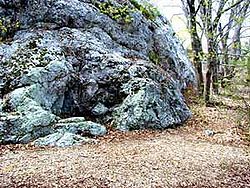 Native American
Native American
inhabitants, including the Wampanoag, Narragansett
, and Niantic
tribes, occupied most of the area now known as Rhode Island. Most of the Native Americans were killed by European diseases and warfare with the Europeans. The Narragansett language died out for many years but was partially preserved in Roger Williams' the A Key into the Languages of America (1643). In the 21st century, the Narragansett tribe remains a federally recognized entity in Rhode Island.
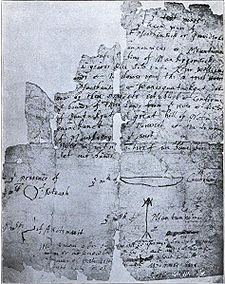
In 1636, Roger Williams
, after being banished from the Massachusetts Bay Colony
for his religious views, settled at the tip of Narragansett Bay, on land granted to him by the Narragansett tribe. He called the site "Providence
" and declared it a place of religious freedom. Detractors of the idea of liberty of conscience sometimes referred to it as "Rogue's Island".
In 1638, after conferring with Williams, Anne Hutchinson
, William Coddington
, John Clarke
, Philip Sherman
, and other religious dissidents settled on Aquidneck Island
(then known as Rhode Island), which was purchased from the local natives, who called it Pocasset. The settlement of Portsmouth
was governed by the Portsmouth Compact
. The southern part of the island became the separate settlement of Newport
after disagreements among the founders.
Another dissident, Samuel Gorton
, purchased the Indian lands at Shawomet in 1642, precipitating a military dispute with the Massachusetts Bay Colony. In 1644, Providence, Portsmouth, and Newport united for their common independence as the Colony of Rhode Island and Providence Plantations
, governed by an elected council and "president". Gorton received a separate charter for his settlement in 1648, which he named Warwick
after his patron. The union of these four towns was strengthened by the Royal Charter of 1663
.
In 1686, King James II
ordered Rhode Island to submit to the Dominion of New England
and its appointed governor Edmund Andros
. This suspended the colony's charter but Rhode Island still managed to retain possession of it until Andros was deposed and the Dominion was dissolved. When William of Orange
became King after the Glorious Revolution
of 1688, Rhode Island's independent government resumed under the 1663 charter, which was used as the state constitution until 1842.
In 1693, the throne of William and Mary
issued a patent extending Rhode Island's territory to three miles "east and northeast" of Narragansett Bay, conflicting with the claims of Plymouth Colony. This resulted in several later transfers of territory between Rhode Island from Massachusetts. (See History of Massachusetts
.)
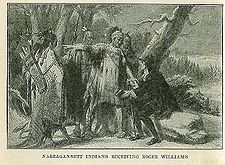 The relationship between the New England
The relationship between the New England
ers and the Native Americans was at first strained, but did not result in much bloodshed. The largest tribes that lived near Rhode Island were the Wampanoag, Pequots, Narragansett
, and Nipmuck
. One native named Squanto
, from the Wampanoag tribe, stayed with the pilgrims and taught them many valuable skills needed to survive in the area. He also helped greatly with the eventual peace between the colonists and the natives.
Roger Williams had won the respect of his colonial neighbors for his skill in keeping the powerful Narragansetts on friendly terms with local white settlers. In 1637, the Narragansetts were even persuaded to form an alliance with the English
in carrying out an attack that nearly extinguished the Pequots. However, this peace did not last long. By 1670, even the friendly tribes who had greeted Williams and the Pilgrims became estranged from the colonists, and smell of war began to cover the New England countryside.
The most important and traumatic event in 17th century Rhode Island was King Philip's War
, which occurred during 1675–1676. King Philip
(his British nickname, his real name was Metacomet
) was the chief of the Wampanoag Indians. The settlers of Portsmouth had purchased their land from his father, Massasoit
. King Philip first led attacks around Narragansett Bay, despite Rhode Island's continued neutrality, but later these spread throughout New England. A force of Massachusetts, Connecticut and Plymouth militia under General Josiah Winslow
invaded and destroyed the fortified Narragansett Indian village in the Great Swamp
in southern Rhode Island, on December 19, 1675. The Narragansett also invaded, and burnt down several of the cities of Rhode Island, including Providence, although they allowed the population to leave first. Also in one of the final actions of the war, troops from Connecticut led by Captain Benjamin Church hunted down and killed "King Philip", as they called the Narragansett war-leader Metacom, at Mount Hope
, which is on Rhode Island's territory.
In 1719, Rhode Island imposed civil restrictions on Catholics.
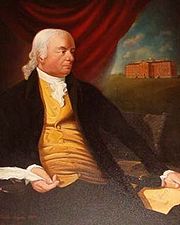
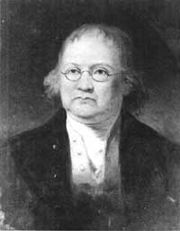
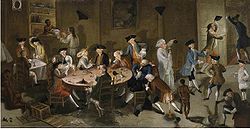 Rhode Island was the first British colony in America to formally declare its independence, doing so on May 4, 1776, a full two months before the national Declaration of Independence
Rhode Island was the first British colony in America to formally declare its independence, doing so on May 4, 1776, a full two months before the national Declaration of Independence
. Previously, in 1772 Rhode Islanders attacked the British warship the Gaspee as one of the first overt acts of rebellion in America. British naval forces under Captain James Wallace controlled Narragansett Bay for much of the Revolution, periodically raiding the islands and the mainland. The British raided Prudence Island
for livestock and engaged in a skirmish with American forces, losing approximately a dozen soldiers. Newport remained a hotbed for Tory or Loyalist sympathizers who assisted the British forces. The state appointed General William West of Scituate to root out Tories in the winter of 1775-76. British forces evenutally occupied Newport from 1777 to 1778 forcing the colonial forces to flee to Bristol.
The Battle of Rhode Island
was fought during the summer of 1778 and was an unsuccessful attempt to expel the British from Narragansett Bay although few colonial casualties occurred. The Marquis de Lafayette called the action the "best fought" of War. The following year, the British, wanting to concentrate their forces in New York, abandoned Newport.
In 1780, the French under Rochambeau landed in Newport and for the rest of the war Newport was the base of the French forces in the United States. The French soldiers behaved themselves so well that in gratitude, the Rhode Island General Assembly repealed an old law banning Catholics from living in Rhode Island. The first Catholic mass in Rhode Island was said in Newport during this time.
Rhode Island was the last of the original 13 states to ratify the United States Constitution
(May 29, 1790)—doing so after being threatened of having its exports taxed as a foreign nation. Rural resistance to the Constitution was strong in Rhode Island, and the anti-federalist Country Party
controlled the General Assembly from 1786 to 1790. In 1788 anti-federalist politician and revolutionary general, William West, led an armed force of 1,000 men to Providence to oppose a 4 July celebration of the 9th state ratifying the Constitution. Civil war was narrowly averted by a compromise limiting the Fourth of July celebration.
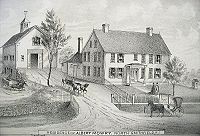 Prior to industrialization, Rhode Island was heavily involved in the slave trade during the post-Revolution era. Slavery was extant in RI as early as the 17th century. In 1652 Rhode Island passed the first abolition law in the thirteen colonies, banning African slavery. The law was not enforced by the end of the century. By 1774, the slave population of RI was 6.3%, nearly twice as high as any other New England colony. In the late 18th century, several Rhode Island merchant families (most notably the Browns, for whom Brown University is named) began actively engaging in the triangle slave trade. In the years after the Revolution, Rhode Island merchants controlled between 60 and 90 percent of the American trade in African slaves. The 18th century Rhode Island's economy depended largely upon the triangle trade, where Rhode Islanders distilled rum from molasses
Prior to industrialization, Rhode Island was heavily involved in the slave trade during the post-Revolution era. Slavery was extant in RI as early as the 17th century. In 1652 Rhode Island passed the first abolition law in the thirteen colonies, banning African slavery. The law was not enforced by the end of the century. By 1774, the slave population of RI was 6.3%, nearly twice as high as any other New England colony. In the late 18th century, several Rhode Island merchant families (most notably the Browns, for whom Brown University is named) began actively engaging in the triangle slave trade. In the years after the Revolution, Rhode Island merchants controlled between 60 and 90 percent of the American trade in African slaves. The 18th century Rhode Island's economy depended largely upon the triangle trade, where Rhode Islanders distilled rum from molasses
, sent the rum to Africa to trade for slaves, and then traded the slaves in the West Indies for more molasses.
While serving in the Rhode Island Assembly in 1774, Stephen Hopkins
introduced a bill that prohibited the importation of slaves into the colony. This became one of the first anti-slavery laws in the new United States. In February 1784 the Rhode Island Legislature passed a compromise measure for gradual emancipation of slaves within Rhode Island. All children of slaves born after March 1 were to be "apprentices," the girls to become free at 18, the boys at 21. By 1840, the census reported only five African Americans enslaved in Rhode Island.
Despite the antislavery laws of 1774, 1784, and 1787, an active international slave trade continued. In 1789 an Abolition Society was organized to secure enforcement of existing laws against the trade. Leading merchants, especially John Brown
and George DeWolf continued to engage in the trade even after it became illegal. After 1770 slaving was never more than a minor aspect of Rhode Island's overall maritime trade.
Using southern cotton cultivated with slave labor, Rhode Island manufactured numerous textiles throughout the early 19th century. By the mid-19th century, many Rhode Islanders were active in the abolitionist movement, particularly Quakers in Newport and Providence such as Moses Brown
.
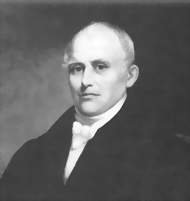 In 1790 English immigrant, Samuel Slater
In 1790 English immigrant, Samuel Slater
founded the first textile mill in the United States in Pawtucket, Rhode Island
(Slater Mill
), and Slater became known as the father of the American industrial revolution. During the 19th century Rhode Island became one of the most industrialized states in the United States with large numbers of textile factories. The state also had significant machine tool, silverware, and costume jewelry industries.
, a permanently landless, and therefore voteless class developed. By 1829, 60% of the state's free white males were ineligible to vote. All efforts at reform failed in the face of rural control of the political system. In 1842 Thomas Dorr drafted a liberal constitution which was passed by popular referendum. However the conservative sitting governor, Samuel Ward King
, opposed the constitution, leading to the Dorr Rebellion
. Although this collapsed, a modified version of the constitution was passed in November, which allowed any white male 21 or older to vote that owned land or could pay a $1 poll tax
.
, Rhode Island was one of the Union states. Rhode Island furnished 25,236 fighting men, of which 1,685 died. On the home front, Rhode Island, along with the other northern states, used its industrial capacity to supply the Union Army with the materials it needed to win the war. Rhode Island's continued growth and modernization led to the creation of an urban mass transit system, and improved health and sanitation programs. After the war, in 1866, Rhode Island abolished racial segregation throughout the state. Post-war immigration increased the population. From the 1860s to the 1880s, most of the immigrants were from England, Ireland, Germany, Sweden, and Quebec. Towards the end of the century however, most immigrants were from South and Eastern Europe, and the Mediterranean. At the turn of the century, Rhode Island had a booming economy, which fed the demand for immigration. In the years that lead up to World War I
, Rhode Island's constitution remained reactionary, in contrast to the more progressive reforms that were occurring in the rest of the country. During World War I, Rhode Island furnished 28,817 troops, of whom 612 died. After the war, the state was hit hard by the Spanish Influenza.
In the 1920s and 30s, rural Rhode Island saw a surge in Ku Klux Klan
membership largely among the native-born white population in reaction to the large waves of immigrants moving to the state. The Klan is believed to be responsible for burning the Watchman Industrial School in Scituate, Rhode Island
, which was a school for African American
children.
 Since the 1935 "Bloodless Revolution" in which Governor Theodore Francis Green and Democratic majorities in the state House and Senate replaced a Yankee Republican dominance that had existed since the middle of the 19th century, the Rhode Island Democratic Party has dominated state politics. Since then, the Speaker of the House, always a Democrat, has been one of the most powerful figures in government. The Democratic Party represented a coalition of labor unions, working class immigrants, intellectuals, college students, and the rising ethnic middle class. The Republican Party has been dominant in rural and suburban parts of the state, and has elected occasional "good government" reform candidates who criticize the state's high taxes and the excesses of Democratic domination. Cranston
Since the 1935 "Bloodless Revolution" in which Governor Theodore Francis Green and Democratic majorities in the state House and Senate replaced a Yankee Republican dominance that had existed since the middle of the 19th century, the Rhode Island Democratic Party has dominated state politics. Since then, the Speaker of the House, always a Democrat, has been one of the most powerful figures in government. The Democratic Party represented a coalition of labor unions, working class immigrants, intellectuals, college students, and the rising ethnic middle class. The Republican Party has been dominant in rural and suburban parts of the state, and has elected occasional "good government" reform candidates who criticize the state's high taxes and the excesses of Democratic domination. Cranston
Mayors Edward D. DiPrete
and Stephen Laffey, Governor Donald Carcieri
of East Greenwich, and former Mayor Vincent A. "Buddy" Cianci of Providence ran as Republican reform candidates.
The state income tax was first enacted in 1971 as a temporary measure. Prior to 1971 there was no income tax in the state, but the temporary income tax soon became permanent. The tax burden in Rhode Island, including sales, gasoline, property, cigarette, corporate, and capital gains taxes, remains among the five highest in the United States.
Rhode Islanders have overwhelmingly supported and re-elected Democrats to positions of authority, where issues involving education, health care, and liberal causes are promoted. As of 2010 Rhode Island has heavily Democratic controlled legislatures, and both U.S. Senators and Congressman, and all statewide offices other than governor are held by Democrats.
Regarding border disputes
Pre-colonization

Native Americans in the United States
Native Americans in the United States are the indigenous peoples in North America within the boundaries of the present-day continental United States, parts of Alaska, and the island state of Hawaii. They are composed of numerous, distinct tribes, states, and ethnic groups, many of which survive as...
inhabitants, including the Wampanoag, Narragansett
Narragansett (tribe)
The Narragansett tribe are an Algonquian Native American tribe from Rhode Island. In 1983 they regained federal recognition as the Narragansett Indian Tribe of Rhode Island. In 2009, the United States Supreme Court ruled against their request that the Department of Interior take land into trust...
, and Niantic
Niantic (tribe)
The Niantic, or in their own language, the Nehântick or Nehantucket were a tribe of New England Native Americans, who were living in Connecticut and Rhode Island during the early colonial period. Due to intrusions of the Pequot, the Niantic were divided into an eastern and western division...
tribes, occupied most of the area now known as Rhode Island. Most of the Native Americans were killed by European diseases and warfare with the Europeans. The Narragansett language died out for many years but was partially preserved in Roger Williams' the A Key into the Languages of America (1643). In the 21st century, the Narragansett tribe remains a federally recognized entity in Rhode Island.
Rhode Island Colony period: 1636–1776

In 1636, Roger Williams
Roger Williams (theologian)
Roger Williams was an English Protestant theologian who was an early proponent of religious freedom and the separation of church and state. In 1636, he began the colony of Providence Plantation, which provided a refuge for religious minorities. Williams started the first Baptist church in America,...
, after being banished from the Massachusetts Bay Colony
Massachusetts Bay Colony
The Massachusetts Bay Colony was an English settlement on the east coast of North America in the 17th century, in New England, situated around the present-day cities of Salem and Boston. The territory administered by the colony included much of present-day central New England, including portions...
for his religious views, settled at the tip of Narragansett Bay, on land granted to him by the Narragansett tribe. He called the site "Providence
Providence, Rhode Island
Providence is the capital and most populous city of Rhode Island and was one of the first cities established in the United States. Located in Providence County, it is the third largest city in the New England region...
" and declared it a place of religious freedom. Detractors of the idea of liberty of conscience sometimes referred to it as "Rogue's Island".
In 1638, after conferring with Williams, Anne Hutchinson
Anne Hutchinson
Anne Hutchinson was one of the most prominent women in colonial America, noted for her strong religious convictions, and for her stand against the staunch religious orthodoxy of 17th century Massachusetts...
, William Coddington
William Coddington
William Coddington was an early magistrate of the Massachusetts Bay Colony, and later of the Colony of Rhode Island and Providence Plantations, serving as the Judge of Portsmouth, Judge of Newport, Governor of Portsmouth and Newport, Deputy Governor of the entire colony, and then Governor of the...
, John Clarke
John Clarke (1609-1676)
John Clarke was a medical doctor, Baptist minister, co-founder of the colony of Rhode Island and Providence Plantations, author of its influential charter, and a leading advocate of religious freedom in the Americas....
, Philip Sherman
Philip Sherman
Philip Sherman was a prominent leader and one of the founding settlers of Portsmouth in the Colony of Rhode Island and Providence Plantations. Coming from Dedham, Essex in southeastern England, he and several of his siblings and cousins settled in New England...
, and other religious dissidents settled on Aquidneck Island
Aquidneck Island
Aquidneck Island, located in the state of Rhode Island, is the largest island in Narragansett Bay. The island's official name is Rhode Island, and the common use of name "Aquidneck Island" helps distinguish the island from the state. The total land area is 97.9 km²...
(then known as Rhode Island), which was purchased from the local natives, who called it Pocasset. The settlement of Portsmouth
Portsmouth, Rhode Island
Portsmouth is a town in Newport County, Rhode Island, United States. The population was 17,389 at the 2010 U.S. Census.-Geography:According to the United States Census Bureau, the town has a total area of , of which, of it is land and of it is water. Most of its land area lies on Aquidneck...
was governed by the Portsmouth Compact
Portsmouth Compact
The Portsmouth Compact was a document signed on March 7, 1638 that established the settlement of Portsmouth, which is now a town in the state of Rhode Island...
. The southern part of the island became the separate settlement of Newport
Newport, Rhode Island
Newport is a city on Aquidneck Island in Newport County, Rhode Island, United States, about south of Providence. Known as a New England summer resort and for the famous Newport Mansions, it is the home of Salve Regina University and Naval Station Newport which houses the United States Naval War...
after disagreements among the founders.
Another dissident, Samuel Gorton
Samuel Gorton
Samuel Gorton , was an early settler and civic leader of the Colony of Rhode Island and Providence Plantations and President of the towns of Providence and Warwick for one term...
, purchased the Indian lands at Shawomet in 1642, precipitating a military dispute with the Massachusetts Bay Colony. In 1644, Providence, Portsmouth, and Newport united for their common independence as the Colony of Rhode Island and Providence Plantations
Colony of Rhode Island and Providence Plantations
The Colony of Rhode Island and Providence Plantations was one of the original English Thirteen Colonies established on the east coast of North America that, after the American Revolution, became the modern U.S...
, governed by an elected council and "president". Gorton received a separate charter for his settlement in 1648, which he named Warwick
Warwick, Rhode Island
Warwick is a city in Kent County, Rhode Island, United States. It is the second largest city in the state, with a population of 82,672 at the 2010 census. Its mayor has been Scott Avedisian since 2000...
after his patron. The union of these four towns was strengthened by the Royal Charter of 1663
Royal Charter of 1663
The Royal Charter of 1663 was a colonial charter giving English royal recognition to the Colony of Rhode Island and Providence Plantations, providing a foundation for the government, and outlining broad freedoms for the inhabitants of that colony...
.
In 1686, King James II
James II of England
James II & VII was King of England and King of Ireland as James II and King of Scotland as James VII, from 6 February 1685. He was the last Catholic monarch to reign over the Kingdoms of England, Scotland, and Ireland...
ordered Rhode Island to submit to the Dominion of New England
Dominion of New England
The Dominion of New England in America was an administrative union of English colonies in the New England region of North America. The dominion was ultimately a failure because the area it encompassed was too large for a single governor to manage...
and its appointed governor Edmund Andros
Edmund Andros
Sir Edmund Andros was an English colonial administrator in North America. Andros was known most notably for his governorship of the Dominion of New England during most of its three-year existence. He also governed at various times the provinces of New York, East and West Jersey, Virginia, and...
. This suspended the colony's charter but Rhode Island still managed to retain possession of it until Andros was deposed and the Dominion was dissolved. When William of Orange
William III of England
William III & II was a sovereign Prince of Orange of the House of Orange-Nassau by birth. From 1672 he governed as Stadtholder William III of Orange over Holland, Zeeland, Utrecht, Guelders, and Overijssel of the Dutch Republic. From 1689 he reigned as William III over England and Ireland...
became King after the Glorious Revolution
Glorious Revolution
The Glorious Revolution, also called the Revolution of 1688, is the overthrow of King James II of England by a union of English Parliamentarians with the Dutch stadtholder William III of Orange-Nassau...
of 1688, Rhode Island's independent government resumed under the 1663 charter, which was used as the state constitution until 1842.
In 1693, the throne of William and Mary
William and Mary
The phrase William and Mary usually refers to the coregency over the Kingdoms of England, Scotland and Ireland, of King William III & II and Queen Mary II...
issued a patent extending Rhode Island's territory to three miles "east and northeast" of Narragansett Bay, conflicting with the claims of Plymouth Colony. This resulted in several later transfers of territory between Rhode Island from Massachusetts. (See History of Massachusetts
History of Massachusetts
Massachusetts was first colonized by principally English Europeans in the early 17th century, and became the Commonwealth of Massachusetts in the 18th century. Prior to English colonization of the area, it was inhabited by a variety of mainly Algonquian-speaking indigenous tribes...
.)
Colonial relations with Native Americans

New England
New England is a region in the northeastern corner of the United States consisting of the six states of Maine, New Hampshire, Vermont, Massachusetts, Rhode Island, and Connecticut...
ers and the Native Americans was at first strained, but did not result in much bloodshed. The largest tribes that lived near Rhode Island were the Wampanoag, Pequots, Narragansett
Narragansett
Narragansett may refer to:*Narragansett , a Pennsylvania Railroad train*Narragansett , an Amtrak train*Narragansett **Narragansett land claim*Narragansett, Rhode Island, a town*Narragansett Bay*Narragansett...
, and Nipmuck
Nipmuck
The Nipmuc are a group of Algonquian Indians native to Worcester County, Massachusetts, some parts of Northeastern CT, and NW RI, and the Northwestern and Western parts of Middlesex County, Massachusetts.-Name:...
. One native named Squanto
Squanto
Tisquantum was a Patuxet. He was the Native American who assisted the Pilgrims after their first winter in the New World and was integral to their survival. The Patuxet tribe was a tributary of the Wampanoag Confederacy.-Biography:Squanto's exact date of birth is unknown but many historians...
, from the Wampanoag tribe, stayed with the pilgrims and taught them many valuable skills needed to survive in the area. He also helped greatly with the eventual peace between the colonists and the natives.
Roger Williams had won the respect of his colonial neighbors for his skill in keeping the powerful Narragansetts on friendly terms with local white settlers. In 1637, the Narragansetts were even persuaded to form an alliance with the English
English people
The English are a nation and ethnic group native to England, who speak English. The English identity is of early mediaeval origin, when they were known in Old English as the Anglecynn. England is now a country of the United Kingdom, and the majority of English people in England are British Citizens...
in carrying out an attack that nearly extinguished the Pequots. However, this peace did not last long. By 1670, even the friendly tribes who had greeted Williams and the Pilgrims became estranged from the colonists, and smell of war began to cover the New England countryside.
The most important and traumatic event in 17th century Rhode Island was King Philip's War
King Philip's War
King Philip's War, sometimes called Metacom's War, Metacomet's War, or Metacom's Rebellion, was an armed conflict between Native American inhabitants of present-day southern New England and English colonists and their Native American allies in 1675–76. The war is named after the main leader of the...
, which occurred during 1675–1676. King Philip
Metacomet
Metacomet , also known as King Philip or Metacom, or occasionally Pometacom, was a war chief or sachem of the Wampanoag Indians and their leader in King Philip's War, a widespread Native American uprising against English colonists in New England.-Biography:Metacomet was the second son of Massasoit...
(his British nickname, his real name was Metacomet
Metacomet
Metacomet , also known as King Philip or Metacom, or occasionally Pometacom, was a war chief or sachem of the Wampanoag Indians and their leader in King Philip's War, a widespread Native American uprising against English colonists in New England.-Biography:Metacomet was the second son of Massasoit...
) was the chief of the Wampanoag Indians. The settlers of Portsmouth had purchased their land from his father, Massasoit
Massasoit
Massasoit Sachem or Ousamequin ,was the sachem, or leader, of the Pokanoket, and "Massasoit" of the Wampanoag Confederacy. The term Massasoit means Great Sachem.-Early years:...
. King Philip first led attacks around Narragansett Bay, despite Rhode Island's continued neutrality, but later these spread throughout New England. A force of Massachusetts, Connecticut and Plymouth militia under General Josiah Winslow
Josiah Winslow
Josiah Winslow was an American Pilgrim leader. He served as governor of Plymouth Colony from 1673 to 1680.Born in Plymouth Colony , he was son of Edward Winslow and Susanna White. In 1651 in London, with his father, he married Penelope Pelham, daughter of Herbert Pelham, the first treasurer of...
invaded and destroyed the fortified Narragansett Indian village in the Great Swamp
Great Swamp Fight
The Great Swamp Fight, or the Great Swamp Massacre, was a crucial battle fought during King Philip's War between colonial militia of New England and the Narragansett tribe in December of 1675.-Battle:...
in southern Rhode Island, on December 19, 1675. The Narragansett also invaded, and burnt down several of the cities of Rhode Island, including Providence, although they allowed the population to leave first. Also in one of the final actions of the war, troops from Connecticut led by Captain Benjamin Church hunted down and killed "King Philip", as they called the Narragansett war-leader Metacom, at Mount Hope
Mount Hope (Rhode Island)
Mount Hope is a small hill in Bristol, Rhode Island overlooking the part of Narragansett Bay known as Mount Hope Bay. The elevation of the summit is 209 feet, and drops sharply to the bay on its eastern side. Mount Hope was the site of a Wampanoag village...
, which is on Rhode Island's territory.
In 1719, Rhode Island imposed civil restrictions on Catholics.
Revolutionary era 1775-1790



Declaration of independence
A declaration of independence is an assertion of the independence of an aspiring state or states. Such places are usually declared from part or all of the territory of another nation or failed nation, or are breakaway territories from within the larger state...
. Previously, in 1772 Rhode Islanders attacked the British warship the Gaspee as one of the first overt acts of rebellion in America. British naval forces under Captain James Wallace controlled Narragansett Bay for much of the Revolution, periodically raiding the islands and the mainland. The British raided Prudence Island
Prudence Island
Prudence Island is the third largest island in Narragansett Bay in the U.S. state of Rhode Island and part of the town of Portsmouth. It is located near the geographical center of the bay. It is defined by the United States Census Bureau as Block Group 3, Census Tract 401.03 of Newport County,...
for livestock and engaged in a skirmish with American forces, losing approximately a dozen soldiers. Newport remained a hotbed for Tory or Loyalist sympathizers who assisted the British forces. The state appointed General William West of Scituate to root out Tories in the winter of 1775-76. British forces evenutally occupied Newport from 1777 to 1778 forcing the colonial forces to flee to Bristol.
The Battle of Rhode Island
Battle of Rhode Island
The Battle of Rhode Island, also known as the Battle of Quaker Hill and the Siege of Newport, took place on August 29, 1778. Continental Army and militia forces under the command of General John Sullivan were withdrawing to the northern part of Aquidneck Island after abandoning their siege of...
was fought during the summer of 1778 and was an unsuccessful attempt to expel the British from Narragansett Bay although few colonial casualties occurred. The Marquis de Lafayette called the action the "best fought" of War. The following year, the British, wanting to concentrate their forces in New York, abandoned Newport.
In 1780, the French under Rochambeau landed in Newport and for the rest of the war Newport was the base of the French forces in the United States. The French soldiers behaved themselves so well that in gratitude, the Rhode Island General Assembly repealed an old law banning Catholics from living in Rhode Island. The first Catholic mass in Rhode Island was said in Newport during this time.
Rhode Island was the last of the original 13 states to ratify the United States Constitution
United States Constitution
The Constitution of the United States is the supreme law of the United States of America. It is the framework for the organization of the United States government and for the relationship of the federal government with the states, citizens, and all people within the United States.The first three...
(May 29, 1790)—doing so after being threatened of having its exports taxed as a foreign nation. Rural resistance to the Constitution was strong in Rhode Island, and the anti-federalist Country Party
Country Party (Rhode Island)
The Country Party, Rhode Island's anti-federalist political party, controlled the Rhode Island General Assembly from 1786 and 1790 and opposed the Federalist Party, which supported the U.S. Constitution. The Federalists were largely from the "town," Providence, Rhode Island, while the Country...
controlled the General Assembly from 1786 to 1790. In 1788 anti-federalist politician and revolutionary general, William West, led an armed force of 1,000 men to Providence to oppose a 4 July celebration of the 9th state ratifying the Constitution. Civil war was narrowly averted by a compromise limiting the Fourth of July celebration.
Slavery

Molasses
Molasses is a viscous by-product of the processing of sugar cane, grapes or sugar beets into sugar. The word molasses comes from the Portuguese word melaço, which ultimately comes from mel, the Latin word for "honey". The quality of molasses depends on the maturity of the sugar cane or sugar beet,...
, sent the rum to Africa to trade for slaves, and then traded the slaves in the West Indies for more molasses.
While serving in the Rhode Island Assembly in 1774, Stephen Hopkins
Stephen Hopkins (politician)
Stephen Hopkins was an American political leader from Rhode Island who signed the Declaration of Independence. He served as the Chief Justice and Governor of the English Colony of Rhode Island and Providence Plantations and was a Delegate to the Colonial Congress in Albany in 1754 and to the...
introduced a bill that prohibited the importation of slaves into the colony. This became one of the first anti-slavery laws in the new United States. In February 1784 the Rhode Island Legislature passed a compromise measure for gradual emancipation of slaves within Rhode Island. All children of slaves born after March 1 were to be "apprentices," the girls to become free at 18, the boys at 21. By 1840, the census reported only five African Americans enslaved in Rhode Island.
Despite the antislavery laws of 1774, 1784, and 1787, an active international slave trade continued. In 1789 an Abolition Society was organized to secure enforcement of existing laws against the trade. Leading merchants, especially John Brown
John Brown (Rhode Island)
John Brown I was an American merchant, slave trader, and statesman from Providence, Rhode Island. In 1764, John Brown joined his brothers Nicholas Brown and Moses Brown as well as William Ellery, the Baptist Reverend James Manning, the Baptist Reverend Isaac Backus, the Congregationalist Reverend...
and George DeWolf continued to engage in the trade even after it became illegal. After 1770 slaving was never more than a minor aspect of Rhode Island's overall maritime trade.
Using southern cotton cultivated with slave labor, Rhode Island manufactured numerous textiles throughout the early 19th century. By the mid-19th century, many Rhode Islanders were active in the abolitionist movement, particularly Quakers in Newport and Providence such as Moses Brown
Moses Brown
Moses Brown was a co-founder of Brown University and a New England abolitionist and industrialist, who funded the design and construction of some of the first factory houses for spinning machines during the American industrial revolution, including Slater Mill.-Early life:Brown was the son of...
.
Industrial Revolution

Samuel Slater
Samuel Slater was an early English-American industrialist known as the "Father of the American Industrial Revolution", or the "Father of the American Factory System" because he brought British textile technology to America. He learned textile machinery as an apprentice to a pioneer in the British...
founded the first textile mill in the United States in Pawtucket, Rhode Island
Pawtucket, Rhode Island
Pawtucket is a city in Providence County, Rhode Island, United States. The population was 71,148 at the 2010 census. It is the fourth largest city in the state.-History:...
(Slater Mill
Slater Mill
A National Historic Landmark, the Slater Mill is located next to the Blackstone River in Pawtucket, Rhode Island. Modeled after cotton spinning mills first established in England, the Slater Mill is the first water-powered cotton spinning mill in North America to utilize the Arkwright system of...
), and Slater became known as the father of the American industrial revolution. During the 19th century Rhode Island became one of the most industrialized states in the United States with large numbers of textile factories. The state also had significant machine tool, silverware, and costume jewelry industries.
Dorr Rebellion
As the Industrial Revolution moved large numbers of workers into the cities, and attracted large numbers of immigrants from IrelandIrish American
Irish Americans are citizens of the United States who can trace their ancestry to Ireland. A total of 36,278,332 Americans—estimated at 11.9% of the total population—reported Irish ancestry in the 2008 American Community Survey conducted by the U.S. Census Bureau...
, a permanently landless, and therefore voteless class developed. By 1829, 60% of the state's free white males were ineligible to vote. All efforts at reform failed in the face of rural control of the political system. In 1842 Thomas Dorr drafted a liberal constitution which was passed by popular referendum. However the conservative sitting governor, Samuel Ward King
Samuel Ward King
Samuel Ward King was the 15th Governor of Rhode Island from 1839 to 1843.King was born in Johnston, Providence County, Rhode Island to William Borden King and Welthian Walton....
, opposed the constitution, leading to the Dorr Rebellion
Dorr Rebellion
The Dorr Rebellion was a short-lived armed insurrection in the U.S. state of Rhode Island led by Thomas Wilson Dorr, who was agitating for changes to the state's electoral system.- Precursors :...
. Although this collapsed, a modified version of the constitution was passed in November, which allowed any white male 21 or older to vote that owned land or could pay a $1 poll tax
Poll tax
A poll tax is a tax of a portioned, fixed amount per individual in accordance with the census . When a corvée is commuted for cash payment, in effect it becomes a poll tax...
.
Civil War to Progressive era: 1860–1929
During the American Civil WarAmerican Civil War
The American Civil War was a civil war fought in the United States of America. In response to the election of Abraham Lincoln as President of the United States, 11 southern slave states declared their secession from the United States and formed the Confederate States of America ; the other 25...
, Rhode Island was one of the Union states. Rhode Island furnished 25,236 fighting men, of which 1,685 died. On the home front, Rhode Island, along with the other northern states, used its industrial capacity to supply the Union Army with the materials it needed to win the war. Rhode Island's continued growth and modernization led to the creation of an urban mass transit system, and improved health and sanitation programs. After the war, in 1866, Rhode Island abolished racial segregation throughout the state. Post-war immigration increased the population. From the 1860s to the 1880s, most of the immigrants were from England, Ireland, Germany, Sweden, and Quebec. Towards the end of the century however, most immigrants were from South and Eastern Europe, and the Mediterranean. At the turn of the century, Rhode Island had a booming economy, which fed the demand for immigration. In the years that lead up to World War I
World War I
World War I , which was predominantly called the World War or the Great War from its occurrence until 1939, and the First World War or World War I thereafter, was a major war centred in Europe that began on 28 July 1914 and lasted until 11 November 1918...
, Rhode Island's constitution remained reactionary, in contrast to the more progressive reforms that were occurring in the rest of the country. During World War I, Rhode Island furnished 28,817 troops, of whom 612 died. After the war, the state was hit hard by the Spanish Influenza.
In the 1920s and 30s, rural Rhode Island saw a surge in Ku Klux Klan
Ku Klux Klan
Ku Klux Klan, often abbreviated KKK and informally known as the Klan, is the name of three distinct past and present far-right organizations in the United States, which have advocated extremist reactionary currents such as white supremacy, white nationalism, and anti-immigration, historically...
membership largely among the native-born white population in reaction to the large waves of immigrants moving to the state. The Klan is believed to be responsible for burning the Watchman Industrial School in Scituate, Rhode Island
Scituate, Rhode Island
Scituate is a town in Providence County, Rhode Island, United States. The population was 10,329 at the 2010 census.-History:Scituate was first settled in 1710 by emigrants from Scituate, Massachusetts...
, which was a school for African American
African American
African Americans are citizens or residents of the United States who have at least partial ancestry from any of the native populations of Sub-Saharan Africa and are the direct descendants of enslaved Africans within the boundaries of the present United States...
children.
Great Depression to present: 1929–2010

Cranston, Rhode Island
Cranston, once known as Pawtuxet, is a city in Providence County, Rhode Island, United States. With a population of 80,387 at the 2010 census, it is the third largest city in the state. The center of population of Rhode Island is located in Cranston...
Mayors Edward D. DiPrete
Edward D. DiPrete
Edward Daniel DiPrete is an American Republican Party politician from Rhode Island.DiPrete served as the 70th Governor of Rhode Island from 1985 to 1991, and was defeated for reelection in a landslide by former federal attorney and millionaire businessman Bruce Sundlun in 1990, who had twice lost...
and Stephen Laffey, Governor Donald Carcieri
Donald Carcieri
Donald L. "Don" Carcieri was the 73rd Governor of the U.S. state of Rhode Island. Carcieri has had a varied vocational background, having worked as a manufacturing company executive, aid relief worker, bank executive and teacher.-Personal background:...
of East Greenwich, and former Mayor Vincent A. "Buddy" Cianci of Providence ran as Republican reform candidates.
The state income tax was first enacted in 1971 as a temporary measure. Prior to 1971 there was no income tax in the state, but the temporary income tax soon became permanent. The tax burden in Rhode Island, including sales, gasoline, property, cigarette, corporate, and capital gains taxes, remains among the five highest in the United States.
Rhode Islanders have overwhelmingly supported and re-elected Democrats to positions of authority, where issues involving education, health care, and liberal causes are promoted. As of 2010 Rhode Island has heavily Democratic controlled legislatures, and both U.S. Senators and Congressman, and all statewide offices other than governor are held by Democrats.
Population
See also
- History of New EnglandHistory of New EnglandThis article presents the History of New England, the oldest clearly defined region of the United States, unique among U.S. geographic regions in that it is also a former political entity. While New England was originally inhabited by indigenous peoples, English Pilgrims and especially Puritans,...
- Colony of Rhode Island and Providence PlantationsColony of Rhode Island and Providence PlantationsThe Colony of Rhode Island and Providence Plantations was one of the original English Thirteen Colonies established on the east coast of North America that, after the American Revolution, became the modern U.S...
- Thirteen ColoniesThirteen ColoniesThe Thirteen Colonies were English and later British colonies established on the Atlantic coast of North America between 1607 and 1733. They declared their independence in the American Revolution and formed the United States of America...
- List of newspapers in Rhode Island in the 18th century
Regarding border disputes
- Washington County, Rhode IslandWashington County, Rhode IslandWashington County, commonly known colloquially as South County, is a county located in the southwestern part of the U.S. state of Rhode Island. Washington County borders Kent County to the north, New London County in Connecticut to the west, Suffolk County in New York to the southwest, the Atlantic...
- Bristol County, Rhode IslandBristol County, Rhode IslandThe border with Bristol County, Massachusetts is rather unusual since the counties both share the same name. The only other instances in which two neighboring counties with the same name share a state border are Sabine County, Texas and Sabine Parish, Louisiana, Union Parish, Louisiana and Union...
- History of MassachusettsHistory of MassachusettsMassachusetts was first colonized by principally English Europeans in the early 17th century, and became the Commonwealth of Massachusetts in the 18th century. Prior to English colonization of the area, it was inhabited by a variety of mainly Algonquian-speaking indigenous tribes...
- History of ConnecticutHistory of ConnecticutThe U.S. state of Connecticut began as three distinct settlements, referred to at the time as "Colonies" or "Plantations". These ventures were eventually combined under a single royal charter in 1662.-Colonies in Connecticut:...
External links
- Providence Journal
- Rhode Island History
- Rhode Island Naval History
- 1853 History of Rhode Island (full text online)
- State of Rhode Island and Providence Plantations at the end of the century by Edward Field. History of the state, published in 1902. (Full text available online.)
- 1663 charter

